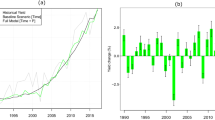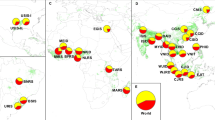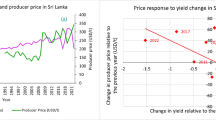Abstract
Extreme climate events constitute a major risk to global food production. Among these, extreme rainfall is often dismissed from historical analyses and future projections, the impacts and mechanisms of which remain poorly understood. Here we used long-term nationwide observations and multi-level rainfall manipulative experiments to explore the magnitude and mechanisms of extreme rainfall impacts on rice yield in China. We find that rice yield reductions due to extreme rainfall were comparable to those induced by extreme heat over the last two decades, reaching 7.6 ± 0.9% (one standard error) according to nationwide observations and 8.1 ± 1.1% according to the crop model incorporating the mechanisms revealed from manipulative experiments. Extreme rainfall reduces rice yield mainly by limiting nitrogen availability for tillering that lowers per-area effective panicles and by exerting physical disturbance on pollination that declines per-panicle filled grains. Considering these mechanisms, we projected ~8% additional yield reduction due to extreme rainfall under warmer climate by the end of the century. These findings demonstrate that it is critical to account for extreme rainfall in food security assessments.
This is a preview of subscription content, access via your institution
Access options
Access Nature and 54 other Nature Portfolio journals
Get Nature+, our best-value online-access subscription
27,99 € / 30 days
cancel any time
Subscribe to this journal
Receive 12 digital issues and online access to articles
118,99 € per year
only 9,92 € per issue
Buy this article
- Purchase on SpringerLink
- Instant access to full article PDF
Prices may be subject to local taxes which are calculated during checkout




Similar content being viewed by others
Data availability
The data from the national agrometeorological observation network and the rainfall manipulative experiments are available in Supplementary Data 1. The climate data, records of extreme climate events, rice yield and phenology at the site scale from the CMA are available at https://data.cma.cn/en. Model input data for historical simulations and future projections are available from public data depositories listed in Supplementary Table 5. The GPM IMERGv6 are available at https://disc.gsfc.nasa.gov/datasets/GPM_3IMERGHH_06/summary. Model output data for historical simulations and future projections are available in Supplementary Data 2. Source data are provided with this paper.
Code availability
Source codes for data analyses are available from https://doi.org/10.6084/m9.figshare.19801765. Source codes for process-based model are available from http://forge.ipsl.jussieu.fr/orchidee, under the French Free Software license, compatible with the GNU GPL (http://cecill.info/licences.en.html).
References
Field, C. B. et al. Managing the Risks of Extreme Events and Disasters to Advance Climate Change Adaptation. A Special Report of Working Groups I and II of the Intergovernmental Panel on Climate Change (Cambridge Univ. Press, 2012).
Lesk, C., Rowhani, P. & Ramankutty, N. Influence of extreme weather disasters on global crop production. Nature 529, 84–87 (2016).
Ray, D. K., Gerber, J. S., MacDonald, G. K. & West, P. C. Climate variation explains a third of global crop yield variability. Nat. Commun. 6, 5989 (2015).
Proctor, J., Rigden, A., Chan, D. & Huybers, P. More accurate specification of water supply shows its importance for global crop production. Nat. Food 3, 753–763 (2022).
Vogel, E. et al. The effects of climate extremes on global agricultural yields. Environ. Res. Lett. 14, 054010 (2019).
Hasegawa, T. et al. Extreme climate events increase risk of global food insecurity and adaptation needs. Nat. Food 2, 587–595 (2021).
Lobell, D. B. et al. Greater sensitivity to drought accompanies maize yield increase in the US Midwest. Science 344, 516–519 (2014).
Lesk, C. et al. Stronger temperature–moisture couplings exacerbate the impact of climate warming on global crop yields. Nat. Food 2, 683–691 (2021).
Wang, X. H. et al. Emergent constraint on crop yield response to warmer temperature from field experiments. Nat. Sustain. 3, 908–916 (2020).
Lobell, D. B., Sibley, A. & Ortiz-Monasterio, J. I. Extreme heat effects on wheat senescence in India. Nat. Clim. Change 2, 186–189 (2012).
Zhang, J. Y., Li, X. M., Lin, H. X. & Chong, K. Crop improvement through temperature resilience. Annu. Rev. Plant Biol. 70, 753–780 (2019).
Lesk, C., Coffel, E. & Horton, R. Net benefits to US soy and maize yields from intensifying hourly rainfall. Nat. Clim. Change 10, 819–822 (2020).
Li, Y., Guan, K. Y., Schnitkey, G. D., DeLucia, E. & Peng, B. Excessive rainfall leads to maize yield loss of a comparable magnitude to extreme drought in the United States. Glob. Change Biol. 25, 2325–2337 (2019).
Webber, H. et al. Diverging importance of drought stress for maize and winter wheat in Europe. Nat. Commun. 9, 4249 (2018).
Seneviratne, S. I. et al. in Climate Change 2021: The Physical Science Basis (eds Masson-Delmotte, V. et al.) 1513–1766 (Cambridge Univ. Press, 2021).
Crops and livestock products. FAOSTAT http://www.fao.org/faostat/en/#home (2019).
Shaw, R. E. & Meyer, W. S. Improved empirical representation of plant responses to waterlogging for simulating crop yield. Agron. J. 107, 1711–1723 (2015).
Zhu, P. et al. The critical benefits of snowpack insulation and snowmelt for winter wheat productivity. Nat. Clim. Change 12, 485–490 (2022).
Wu, X. S. et al. On the event-based extreme precipitation across China: time distribution patterns, trends, and return levels. J. Hydrol. 562, 305–317 (2018).
Lesk, C. et al. Compound heat and moisture extreme impacts on global crop yields under climate change. Nat. Rev. Earth Environ. 3, 872–889 (2022).
Hou, X. K. et al. Detection and attribution of nitrogen runoff trend in China’s croplands. Environ. Pollut. 234, 270–278 (2018).
Gao, S. S. et al. Quantifying nitrogen leaching response to fertilizer additions in China’s cropland. Environ. Pollut. 211, 241–251 (2016).
Steiner, J. L., Briske, D. D., Brown, D. P. & Rottler, C. M. Vulnerability of Southern Plains agriculture to climate change. Clim. Change 146, 201–218 (2018).
Mäkinen, H. et al. Sensitivity of European wheat to extreme weather. Field Crop Res. 222, 209–217 (2018).
Reichstein, M. et al. Climate extremes and the carbon cycle. Nature 500, 287–295 (2013).
Win, A., Tanaka, T. S. T. & Matsui, T. Panicle inclination influences pollination stability of rice (Oryza sativa L.). Plant Prod Sci 23, 60–68 (2020).
Wang, X. H. Impacts of Environmental Change on Rice Ecosystems in China: Development, Optimization and Application of ORCHIDEE-CROP Model. PhD thesis, Peking Univ. (2016).
Yin, Z. et al. Improvement of the irrigation scheme in the ORCHIDEE land surface model and impacts of irrigation on regional water budgets over China. J. Adv. Model Earth Syst. 12, e2019MS001770 (2020).
Huffman, G. J., Stocker, E. F., Bolvin, D. T., Nelkin, E. J. & Tan, J. GPM IMERG Final Precipitation L3 Half Hourly 0.1 degree x 0.1 degree V06, Greenbelt, MD. Goddard Earth Sciences Data and Information Services Center https://disc.gsfc.nasa.gov/datasets/GPM_3IMERGHH_06/summary (2019).
Cui, X. Q. et al. Global mapping of crop-specific emission factors highlights hotspots of nitrous oxide mitigation. Nat. Food 2, 886–893 (2021).
Jian, Y. W., Fu, J., Li, B. G. & Zhou, F. Increased extreme hourly precipitation over China’s rice paddies from 1961 to 2012. Sci. Rep. 10, 10609 (2020).
Rosenzweig, C. et al. Assessing agricultural risks of climate change in the 21st century in a global gridded crop model intercomparison. Proc. Natl Acad. Sci. USA 111, 3268–3273 (2014).
Jägermeyr, J. et al. Climate impacts on global agriculture emerge earlier in new generation of climate and crop models. Nat. Food 2, 873–885 (2021).
Yang, H., Jiang, Z. H. & Li, L. Biases and improvements in three dynamical downscaling climate simulations over China. Clim. Dyn. 47, 3235–3251 (2016).
Chen, W. L., Jiang, Z. H., Li, L. & Yiou, P. Simulation of regional climate change under the IPCC A2 scenario in southeast China. Clim. Dyn. 36, 491–507 (2011).
Barbier, F. F., Dun, E. A., Kerr, S. C., Chabikwa, T. G. & Beveridge, C. A. An update on the signals controlling shoot branching. Trends Plant Sci. 24, 220–236 (2019).
Bailey-Serres, J., Parker, J. E., Ainsworth, E. A., Oldroyd, G. E. D. & Schroeder, J. I. Genetic strategies for improving crop yields. Nature 575, 109–118 (2019).
Iizumi, T. et al. Prediction of seasonal climate-induced variations in global food production. Nat. Clim. Change 3, 904–908 (2013).
Meier, J., Zabel, F. & Mauser, W. A global approach to estimate irrigated areas—a comparison between different data and statistics. Hydrol. Earth Syst. Sci. 22, 1119–1133 (2018).
Lepore, C., Allen, J. T. & Tippett, M. K. Relationships between hourly rainfall intensity and atmospheric variables over the contiguous United States. J. Clim. 29, 3181–3197 (2016).
Atlas, D., Srivastava, R. C. & Sekhon, R. S. Doppler radar characteristics of precipitation at vertical incidence. Rev. Geophys. 11, 1–35 (1973).
Higashino, M. & Stefan, H. G. Modeling the effect of rainfall intensity on soil-water nutrient exchange in flooded rice paddies and implications for nitrate fertilizer runoff to the Oita River in Japan. Water Resour. Res. 50, 8611–8624 (2014).
Yoon, D. K. et al. Transgenic rice overproducing Rubisco exhibits increased yields with improved nitrogen-use efficiency in an experimental paddy field. Nat. Food 1, 134–139 (2020).
Gravois, K. A. & Helms, R. S. Effect of uneven emergence on rice yield, milling yield, and yield components. Aust. J. Exp. Agr. 34, 949–952 (1994).
Wang, S. A. et al. Reduced sediment transport in the Yellow River due to anthropogenic changes. Nat. Geosci. 9, 38–41 (2016).
Ishibashi, M. & Terashima, I. Effects of continuous leaf wetness on photosynthesis—adverse aspects of rainfall. Plant Cell Environ. 18, 431–438 (1995).
Bollen, K. A. Total, direct, and indirect effects in structural equation models. Sociol. Methodol. 17, 37–69 (1987).
Wang, X. H. et al. Management outweighs climate change on affecting length of rice growing period for early rice and single rice in China during 1991–2012. Agric. For. Meteorol. 233, 1–11 (2017).
Müller, C. et al. Global gridded crop model evaluation: benchmarking, skills, deficiencies and implications. Geosci. Model Dev. 10, 1403–1422 (2017).
Wu, X. et al. ORCHIDEE-CROP (v0), a new process-based agro-land surface model: model description and evaluation over Europe. Geosci. Model Dev. 9, 857–873 (2016).
Kobayasi, K., Matsui, T., Yoshimoto, M. & Hasegawa, T. Effects of temperature, solar radiation, and vapor-pressure deficit on flower opening time in rice. Plant Prod. Sci. 13, 21–28 (2010).
Julia, C. & Dingkuhn, M. Variation in time of day of anthesis in rice in different climatic environments. Eur. J. Agron. 43, 166–174 (2012).
Hempel, S., Frieler, K., Warszawski, L., Schewe, J. & Piontek, F. A trend-preserving bias correction—the ISI-MIP approach. Earth Syst. Dyn. 4, 219–236 (2013).
Acknowledgements
This study was supported by the National Natural Science Foundation of China (42225102 and 41977082, F.Z.; 42007079, J.F.; 42171096, X.W.; 41530528, S.L.P). We acknowledge K. Liu, J. Wang and L. Shu from Jingzhou Agrometeorological Experimental Station, S. Wang, W. Adalibieke, Y. Bo, C. Wu, W. Jiang, M. Yuan, H. Cai and C. Wang from Peking University, X. Huang, L. Chen and D. Zhuang from Central China Normal University and C. Li from South China Sea Institute of Oceanography, Chinese Academic of Science for supporting field experiments and laboratory analyses. We acknowledge the CMA for nationwide observations of rice yield, phenology, hourly precipitation and extreme climate events, and the NASA for GPM IMERGv6 data.
Author information
Authors and Affiliations
Contributions
F.Z. designed the study. Y.J., J.F. and X.W. performed all computational analyses. F.Z., X.W., J.F. and Y.J. drafted the paper. L.L. provided high-resolution climate projection using the IPSL model. All co-authors reviewed and commented on the paper.
Corresponding author
Ethics declarations
Competing interests
The authors declare no competing interests.
Peer review
Peer review information
Nature Food thanks David Makowski, Yan Li and the other, anonymous, reviewer(s) for their contribution to the peer review of this work.
Additional information
Publisher’s note Springer Nature remains neutral with regard to jurisdictional claims in published maps and institutional affiliations.
Supplementary information
Supplementary Information
Supplementary Texts 1 and 2, Figs. 1–23, Tables 1–5 and Data 1 and 2.
Supplementary Data 1
Long-term nationwide observations and multi-level rainfall manipulative experiments dataset.
Supplementary Data 2
Model output data.
Source data
Source Data Fig. 1
Statistical source data.
Source Data Fig. 2
Statistical source data.
Source Data Fig. 3
Statistical source data.
Source Data Fig. 4
Statistical source data.
Rights and permissions
Springer Nature or its licensor (e.g. a society or other partner) holds exclusive rights to this article under a publishing agreement with the author(s) or other rightsholder(s); author self-archiving of the accepted manuscript version of this article is solely governed by the terms of such publishing agreement and applicable law.
About this article
Cite this article
Fu, J., Jian, Y., Wang, X. et al. Extreme rainfall reduces one-twelfth of China’s rice yield over the last two decades. Nat Food 4, 416–426 (2023). https://doi.org/10.1038/s43016-023-00753-6
Received:
Accepted:
Published:
Issue Date:
DOI: https://doi.org/10.1038/s43016-023-00753-6
This article is cited by
-
China’s Well-Facilitated Farmland distribution dataset
Scientific Data (2025)
-
European compound flood-heat-flood events associated with Omega patterns cannot be easily reproduced by a fully coupled model
Communications Earth & Environment (2025)
-
Cost-effective adaptations increase rice production while reducing pollution under climate change
Nature Food (2025)
-
GloRice, a global rice database (v1.0): I. Gridded paddy rice annual distribution from 1961 to 2021
Scientific Data (2025)
-
Natural variation of indels in the CTB3 promoter confers cold tolerance in japonica rice
Nature Communications (2025)



